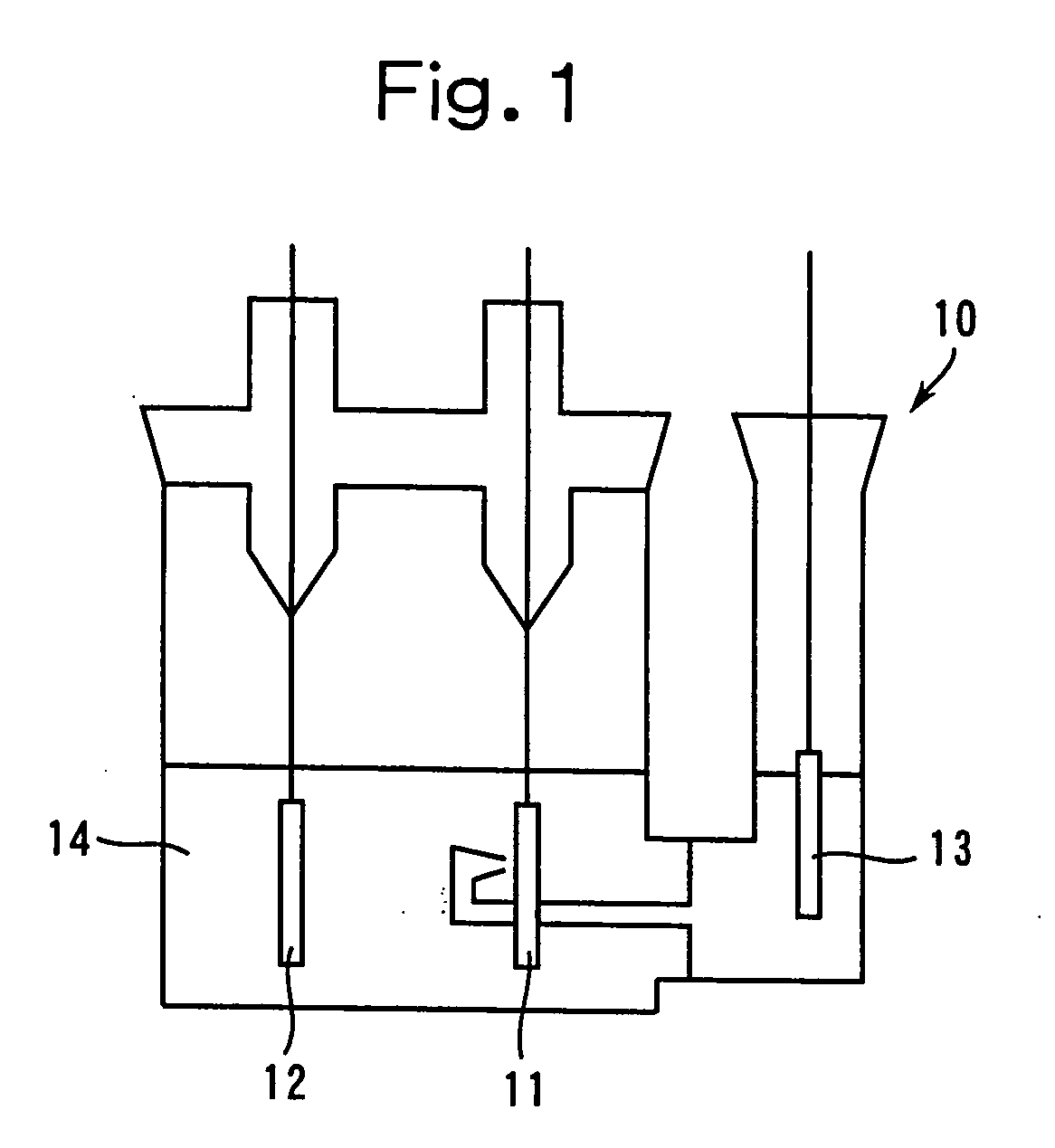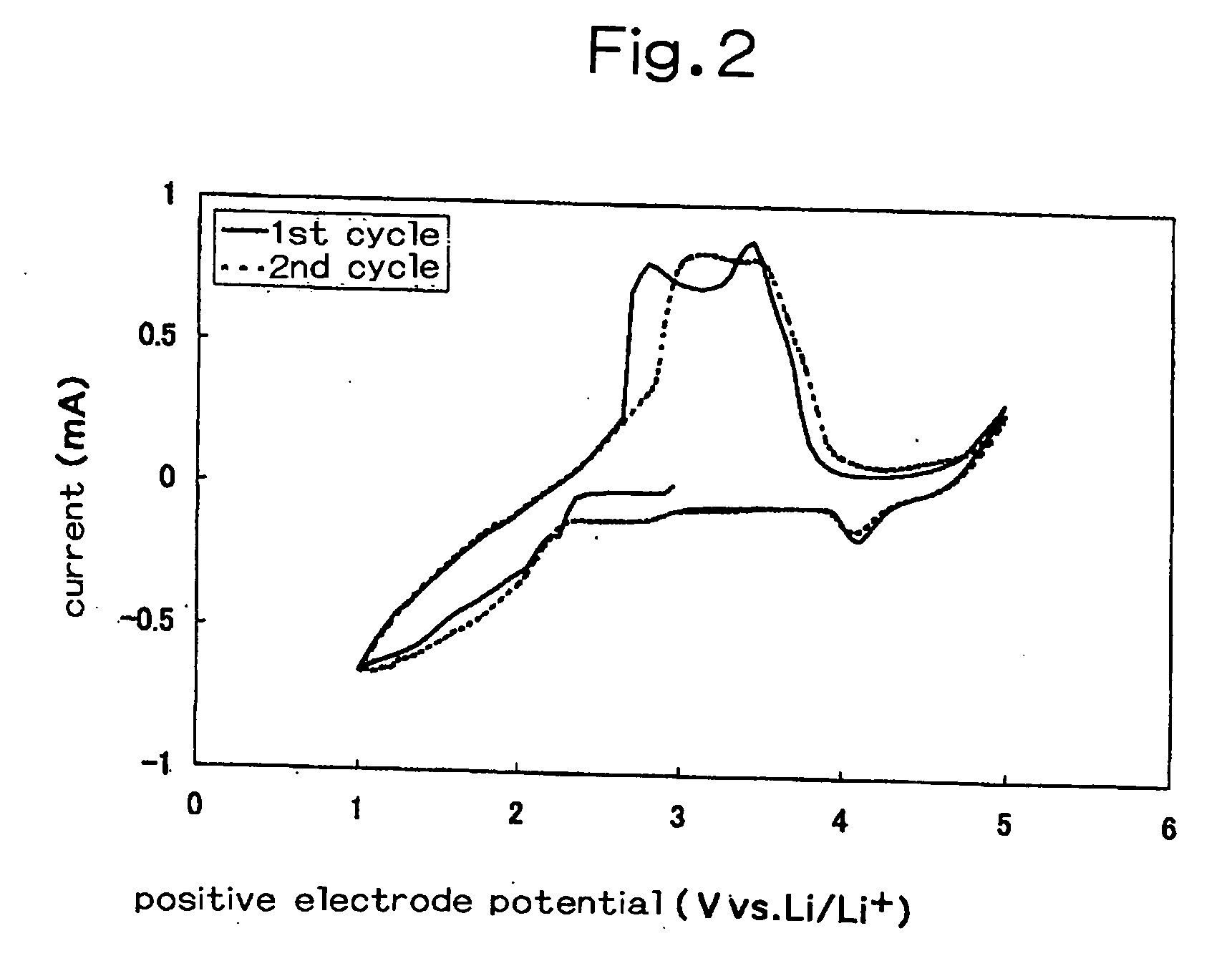Positive electrode, non-aqueous electrolyte secondary battery, and method of manufacturing the same
a technology of non-aqueous electrolyte secondary batteries and positive electrodes, which is applied in the direction of non-aqueous electrolyte cells, cell components, electrochemical generators, etc., can solve the problems of organic disulfide compounds used as positive electrode materials reacting reversibly with lithium, requiring further increase in capacity and energy density of lithium secondary batteries,
- Summary
- Abstract
- Description
- Claims
- Application Information
AI Technical Summary
Benefits of technology
Problems solved by technology
Method used
Image
Examples
##ventive example 1
Inventive Example 1
[0146] In Inventive Example 1, a non-aqueous electrolyte including a lithium salt, LiN(CF.sub.3SO.sub.2).sub.2, dissolved at a concentration of 0.3 mol / l in a room temperature molten salt, trimethylpropylammonium bis(trifluoromethylsulfonyl)imide ((CH.sub.3).sub.3N.sup.+(C.sub.3H.sub.7-)N.sup.-(SO.sub.2CF.sub.3).sub.2) was used.
[0147] For a positive electrode, 20% by weight of elemental sulfur, 70% by weight of acetylene black as conductive agent, and 10% by weight of polytetrafluoroethylene as binder were mixed, and the resultant mixture was ground in a mortar for 30 minutes, then pressed in a mold for five seconds under a pressure of 150 kg / cm.sup.2 to give a disk-shaped material having a diameter of 10.3 mm. This material was wrapped in a net made of aluminum to be used as a positive electrode.
[0148] As shown in FIG. 1, the above-mentioned non-aqueous electrolyte 14 was poured into the test cell vessel 10, while the above-mentioned positive electrode was used f...
##ventive example 2
Inventive Example 2
[0159] In Inventive Example 2, the same non-aqueous electrolyte as that in the above-mentioned Inventive Example 1 was used. As a working electrode 11, an amorphous silicon thin film formed by sputtering on a copper foil having an electrolytically treated surface and formed into a 2 cm.times.2 cm size was used.
[0160] A DC pulse sputtering apparatus was used. An argon (Ar) gas was used for atmospheric gas, and a 99.999% single silicon crystal for a target. The flow rate of the argon gas was set to 60 sccm, and the pressure of the sputtering atmosphere was set to 2.times.10.sup.-1 Pa. The electric power of sputtering was set to 2000 W (6.7 W / cm.sup.2.)
[0161] The initial substrate temperature was set to 25.degree. C. The maximum temperature was approximately 100.degree. C. metal was used for each of a counter electrode 12 and a reference electrode 13, to prepare a test cell of Inventive Example 2.
##ventive example 3
Inventive Example 3
[0166] In Inventive Example 3, a non-aqueous electrolyte including a lithium salt, LiPF.sub.6 dissolved at a concentration of 1 mol / l in a mixed solvent of tetrafluoropropylene carbonate and a quaternary ammonium salt, trimethylpropylammonium bis(trifluoromethylsulfonyl)imide ((CH.sub.3).sub.3N.sup.+(C.sub.3H.sub.7)N.sup.-(SO.sub.2CF.sub.3).sub.2) at a volume ratio of 1:1 was used. Otherwise, test cell of Inventive Example 3 was prepared as in the case of the above-mentioned Inventive Example 1.
PUM
| Property | Measurement | Unit |
|---|---|---|
| melting point | aaaaa | aaaaa |
| pressure | aaaaa | aaaaa |
| temperatures | aaaaa | aaaaa |
Abstract
Description
Claims
Application Information
 Login to View More
Login to View More - R&D
- Intellectual Property
- Life Sciences
- Materials
- Tech Scout
- Unparalleled Data Quality
- Higher Quality Content
- 60% Fewer Hallucinations
Browse by: Latest US Patents, China's latest patents, Technical Efficacy Thesaurus, Application Domain, Technology Topic, Popular Technical Reports.
© 2025 PatSnap. All rights reserved.Legal|Privacy policy|Modern Slavery Act Transparency Statement|Sitemap|About US| Contact US: help@patsnap.com



